 The stage costumes in the recent TV show The Witcher are rather beautiful, skillfully made, and eye-catching. They are a mix of medieval-style clothing, contemporary fashion ideas, and Gothic 1890s and 1930s fashion trends. The costume designer of this series Tim Aslam did his best to make these outfits accentuate the character’s nature, temper, mood, and position. Let us show you all that on examples. This material is dedicated to the movie costumes of characters from Cintra kingdom – Calanthe, Cirilla, Pavetta, Eist Tuirseach, and Mousesack.
The stage costumes in the recent TV show The Witcher are rather beautiful, skillfully made, and eye-catching. They are a mix of medieval-style clothing, contemporary fashion ideas, and Gothic 1890s and 1930s fashion trends. The costume designer of this series Tim Aslam did his best to make these outfits accentuate the character’s nature, temper, mood, and position. Let us show you all that on examples. This material is dedicated to the movie costumes of characters from Cintra kingdom – Calanthe, Cirilla, Pavetta, Eist Tuirseach, and Mousesack.
This article is based on the video from a YouTube channel “Costume CO”.
In this article, we're digging deep into some of the themes of The Witcher costumes, cultural and historical influences on the costume design. And we’ll also analyze the costume styles in Cintra kingdom: outfits of Calanthe, Cirilla, Pavetta, Eist Tuirseach, and Mousesack.
Inspiration for The Witcher costumes
Regarding his design process for the costumes of The Witcher, Tim Aslam says, “I started with in-depth discussions with showrunner Lauren Hissrich about the kind of look and feel she wanted for the show. I came up with a concept which was a mix of contemporary high fashion with Gothic influences from all the periods where Gothic researched in fashion history – notably, the 1890s and 1930s. Plus a lot of ethnic world costume”.
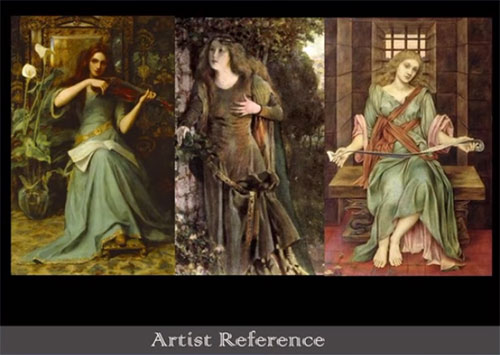
Tim says, “The Witcher is set, after all, in a kind of parallel fantasy world, where anything is possible. I have always particularly loved 1930s fashion. So it was ideal to be able to bring in the ‘30s Gothic feel, along with a little film noir feel, to some of the characters’ costumes. The influences came from a variety of designers of the time – Vionnet, Fortuny, and Alix Barton. Plus Schiaparelli, Lucien Lelong, Maria Monaci Gallenga, and a touch of Joan Crawford”.
Gothic Revival, sometimes called neo-Gothic or Victorian Gothic, was an architectural movement that saw a revival of medieval Gothic architecture. In turn, this movement also influenced art, music, literature, and clothing. It was in stark contrast to the neoclassical movement that saws through the early 1800s.
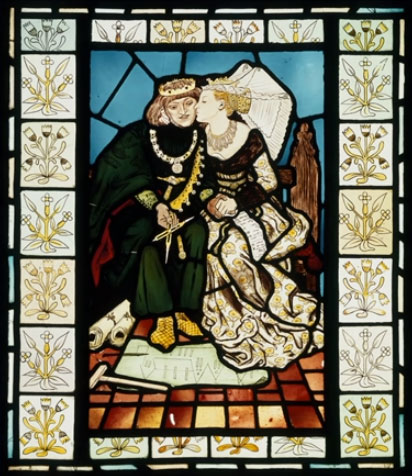
Stained and painted glass panel, 1862, England
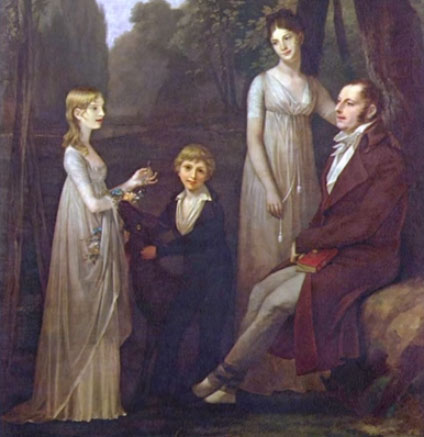
Oil on canvas, Pierre-Paul Prud’hon, 1801-02
What's interesting about Gothic Revival clothing is that both the 1890s and 1930s share many similarities with each other, but also moral aspects from medieval, although not directly.
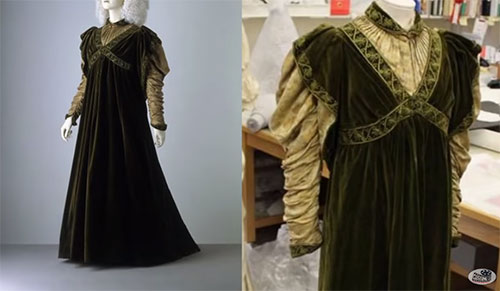
1894 dress, Liberty and Co
Fashion writer Dolores Monet writes, “Aesthetic fashion [as we see during the Aesthetic Movement] cast off the stiffly tailored garments of Victorian style to embrace softer, more comfortable clothing based on the historic costume of medieval times. The Aesthetics viewed corsets and the rigidity of the day as unattractive and artificial. It was, in essence, a fashion revolution”.
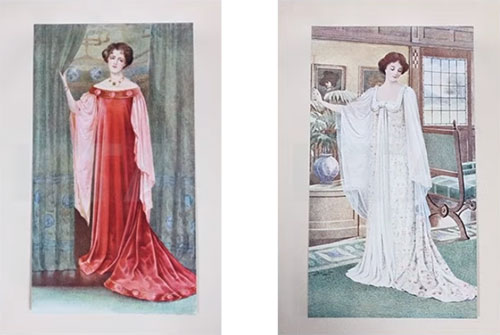
Liberty and Co dresses, 1908
Dolores Monet adds that, instead of stiff bodices, the women wore long flowing dresses with soft pleats, folds, and smocking. Dresses offered few embellishments – unlike the heavily trimmed, ruffled, or braided edges often seen in mid-19th-century clothing.
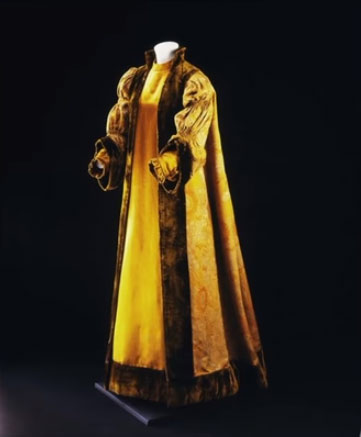
1897 robe, Liberty and Co
Dyes were natural vegetable dyes. The Aesthetics hated the new manufactured aniline dyes. Colors were muted, natural tones of brown, terra cotta, russet red, cobalt or indigo blue and sage or moss green.
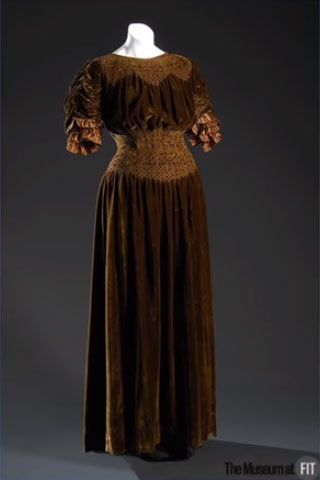
1910 dress, Liberty of London
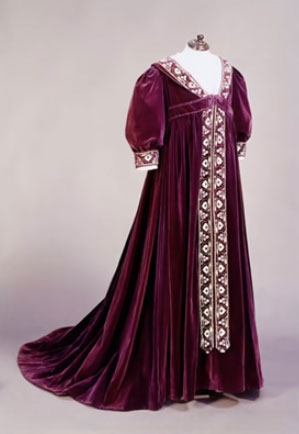
1895-1900 silk velvet tea gown
Costumes of Cintra kingdom
Cintra embodies the channeling of a medieval nostalgia, while not actually being a purely medieval setting.
This is Tim Aslam's mood board for Cintra.
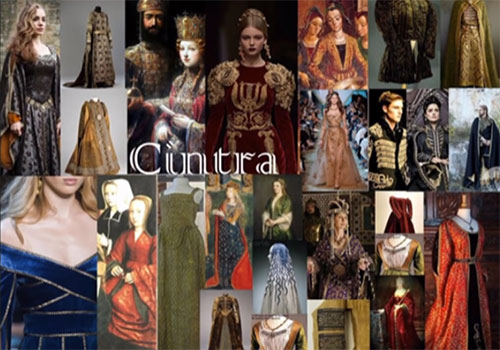
He says, “Cintra was to be rich ethereal colors – golds, bronzes, silvers, and jewel colors. Also, a lot of the backgrounds in Cintra were based on medieval Slavic robes, as well as the look of the crowd”.
Costumes of Calanthe, queen of Cintra
Calanthe, queen of Cintra, is also the mother of Pavetta and grandmother of Ciri.
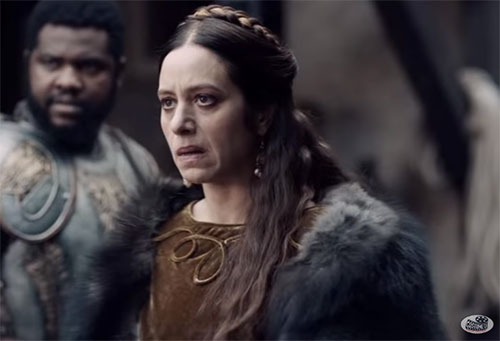
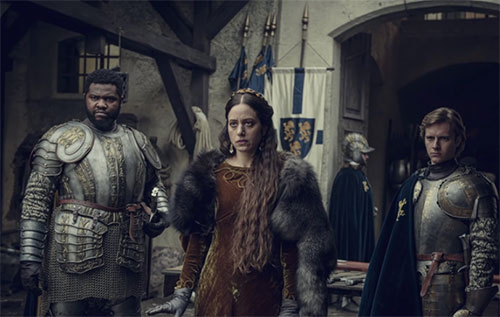
Many of the Gothic elements, like we see in this silk bias-cut gown, are primarily seen on Calanthe, Ciri, and the other women of the court. The gowns are devoid of elaborate trimmings, similar to the styles of the 1930s.
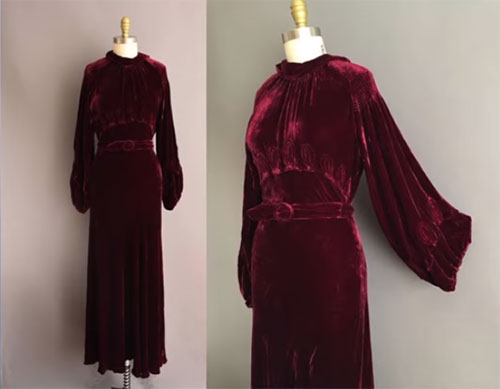
1930s silk velvet gown, Etsy
The Gothic simplicity is from historical examples, like “La Diva” evening dress by Jeanne Lanvin. This 1930s silk velvet gown and this golden bias-cut gown from American designer Valentina, who was inspired by Madeline Vionnet.
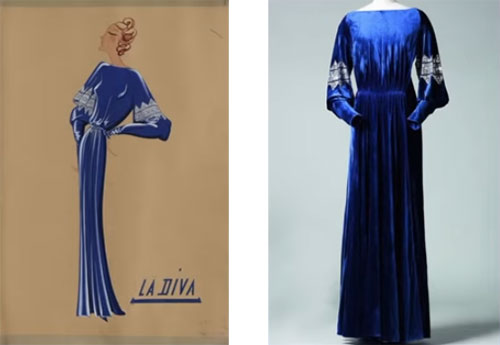
Evening dress, 1935-36, House of Lanvin
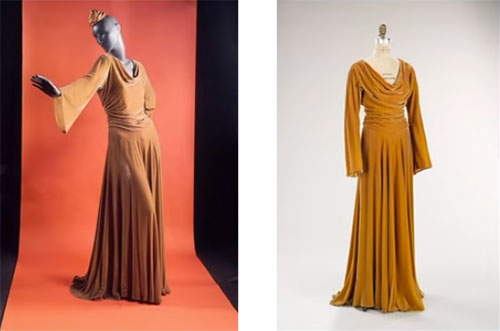
1939 medieval-inspired evening gown, Valentina
Tim Aslam also applied some modern techniques and fabrications, as we see from some of his inspirations in this mood board.

Calanthe’s dress is embellished around the neckline and sleeves with the technique called “surface cording”.

We also see this same technique applied to Ciri’s gown.
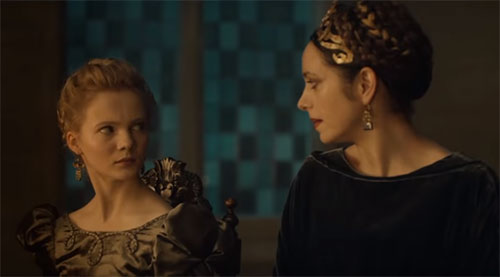
Calanthe wears this gold gown to a banquet after battle. It is made of gold sequence, chosen to give the dress its feeling of chain mail as a reflection of Calanthe’s strong juxtaposition of tradition and strength.

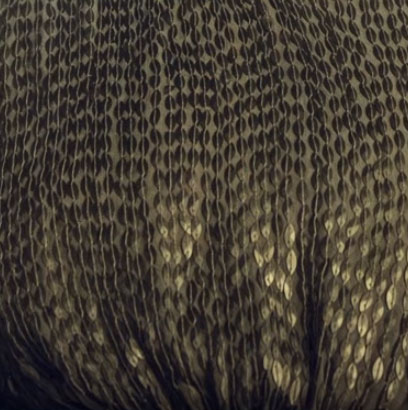
She also wears a royal blue velvet cloak with Cintra's iconic gold embroidered lions.
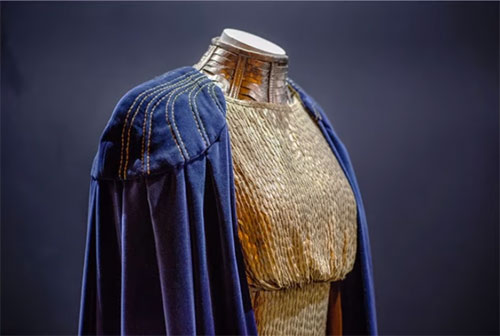
This close-up of the gold leather neck gorget features some modern fabric-sewing techniques.
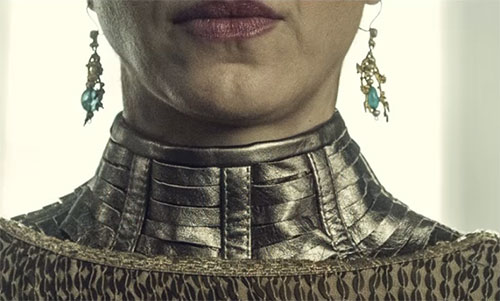
Here is an example of a 1930s metallic gold silk lemay bias-cut evening gown that has a similar effect.

And here is a close-up of Calanthe’s crown.
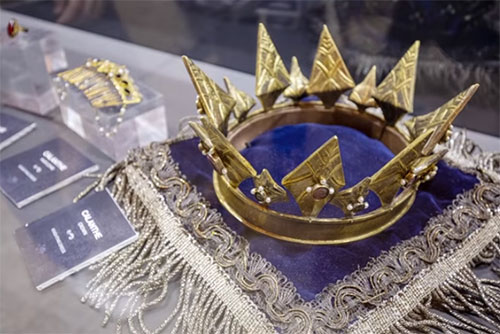
This is a gown seen in a flashback scene in Episode 4. It’s made of beautiful brocade and has the addition of beading around the torso, cape shoulders, and wrists that creates this almost armored feel.
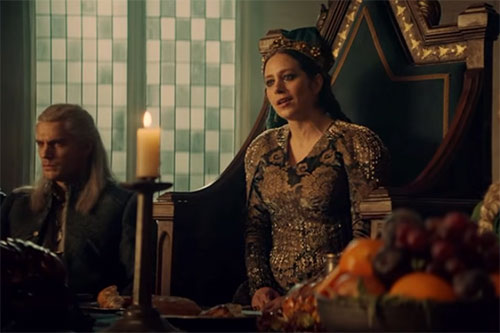
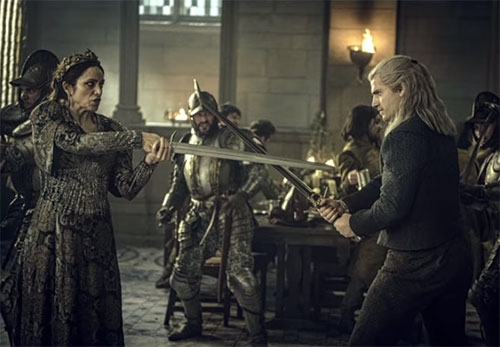
Ciri, princess of Cintra
Cirilla or Ciri, as she is called, is the sole princess of Cintra, the daughter of Pavetta and queen Calanthe’s granddaughter.
We first see Ciri playing with some boys inside the castle walls of Cintra. She's disguised as a boy dressed in a simple doublet and knickers.
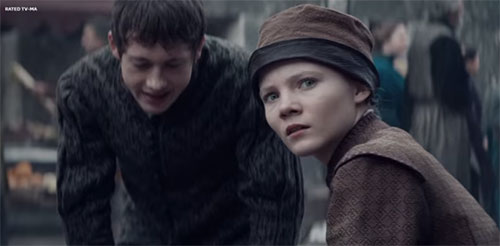
She changes for court into this velvet gown.
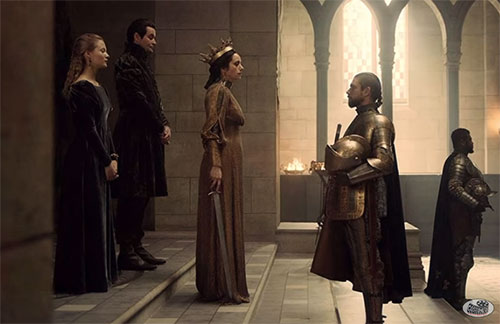
The dress is made from gray silk velvet with a bit of purple for punch.
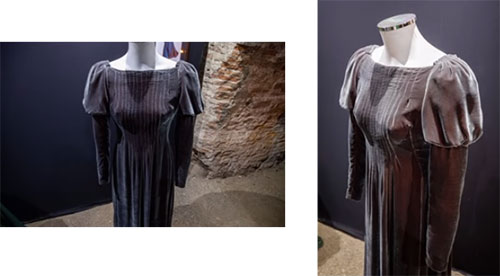
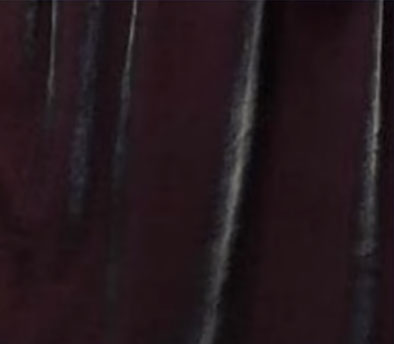
The silhouette is a callback to this style of evening gowns, like this Madeleine Vionnet gown and this one by American designer Elizabeth Hawes, who use similar design techniques. Both of these dresses are from The Met.
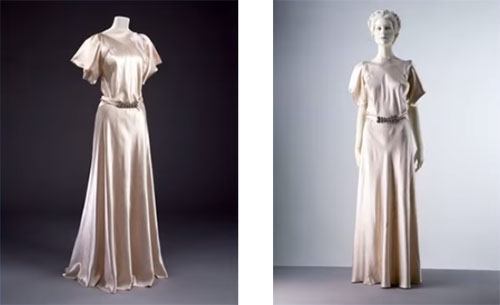
Evening dress, 1932-34, Madeleine Vionnet
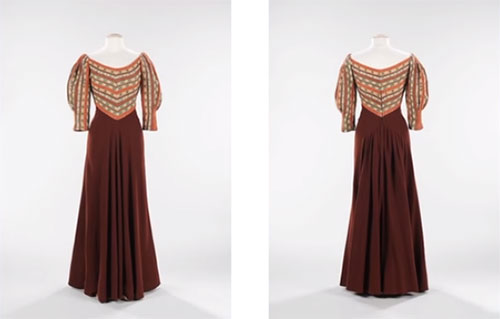
Evening dress, 1935, Elizabeth Hawes
This 1930s ivory silk velvet dress with its medieval influence is evocative of the silhouette of the 1930s.
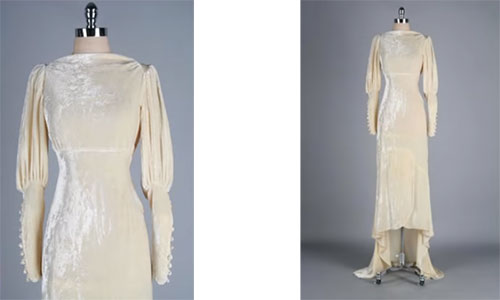
1930s wedding dress, Etsy
In this close-up, you see that the fullness of the dress is pleated along the bodice, and the sleeves are drawn in at the shoulders with some tight cartridge pleats.
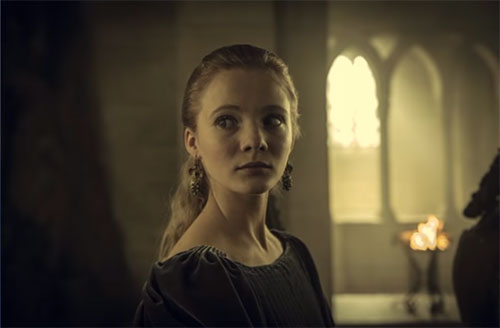
Ciri’s travel outfit is a brocade doublet and split skirt trimmed with wide bands of contrasting fabric. The skirt is actually a wide culotte pants allowing for free movement as she faces her long journey to survive. The costume is functional but still pretty enough for a princess.
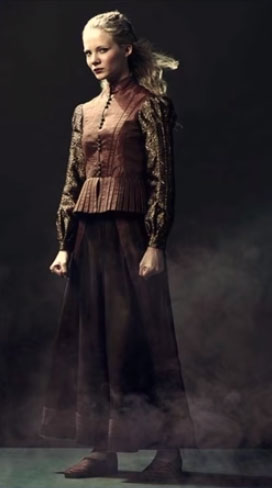
In this image, you can see the construction details of the doublet – contrasting brocade sleeves tapered into a pintuck detail and set into a tailored bronze bodice with a flat-pleated peplum. The doublet is fastened at the center front with a row of metallic buttons.
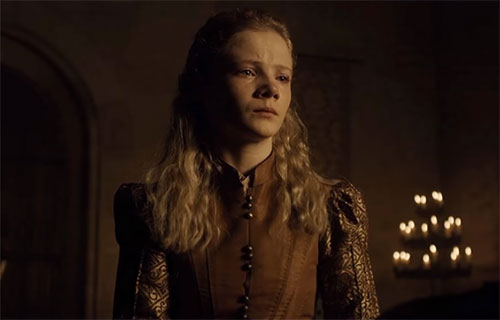
Here is Ciri’s blue cloak, an outer garment that she wears for the remainder of the season. The hooded cloak helps conceal her identity as princess Cirilla. A pleated swirling detail added to the back of the cloak gives it a personal touch of the beauty and otherworldly character that is Ciri.
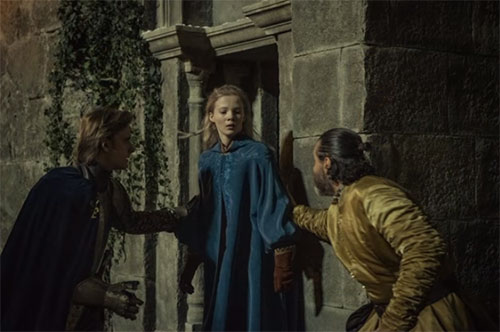
The blue cloak also gives Ciri a sort of an Alice in Wonderland type quality. Tim Aslam says that there was an intention to create this look for Ciri to set her slightly apart from everyone else and convey the kind of confused wonder that she experiences during the season to this world that is alien to her.
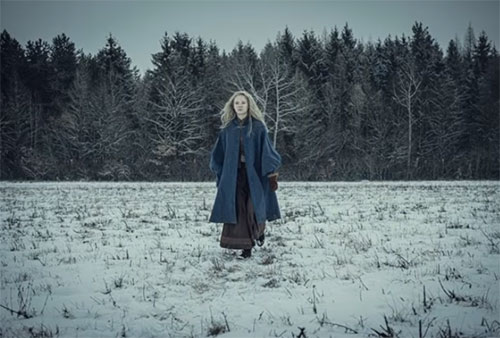
Here's a close-up of the delicate tone-on-tone soutache embroidery trimming the hood, shoulders, and the front of the cape.
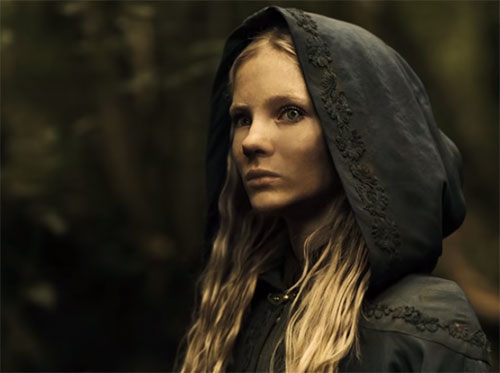
This is a similar technique that we see here on two vintage garments from the 1940s.

Despite Ciri having one costume to carry her throughout the season, Ciri’s runaway look has 12 repeats, according to Tim Aslam, which are at various stages of distress during her journey.
You can see how much brighter her costume is in real life. Tim Aslam said, “I tried to pump up the color as much as possible, especially as once-through breakdown and with use of filters which darkened and desaturated the color – about 40% is lost in some scenes”.

Pavetta, princess of Cintra
Princess Pavetta is the daughter of queen Calanthe and the mother of Ciri. Pavetta only appears in Episode 7 in a flashback sequence, wearing this dress.
Tim Aslam says that “Pavetta’s dress had to be special, it was already described as emerald green. The fact that she is defiant of Calanthe’s wishes as to whom she marries and then takes center stage when the action kicks off meant she had to be the focal point in the scene”.

The swirling cut of both the bodice and sleeve heads of the dress were a subtle indication of her powers.

The dress is cut to give a swirling effect over the bodice and sleeves and is embroidered with fine golden thread to catch the light. Its overskirts of fine golden vein silk intend to give it a floating effect when caught by a breeze. To add depth, the dress has a gentle ombre of darker green tones added to the hems of both the skirts and sleeves.
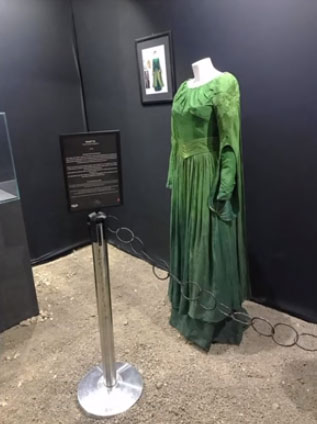
There are some examples of the type of modern pleating techniques used in the dress.
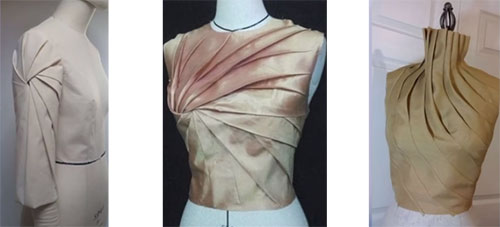
The jewelry worn by Pavetta, along with many in the court of Cintra, is exquisite. Tim Aslam says, “I purchased a lot of jewelry in Turkey from a supplier I had also used in the past on block sales”.
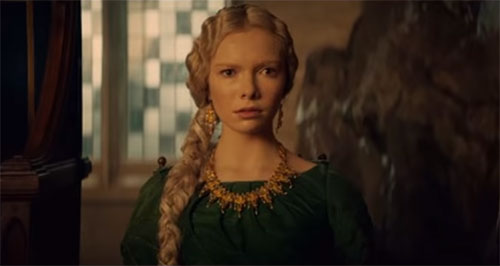
Pavetta’s jewelry is similar to the style of South Indian jewelry.
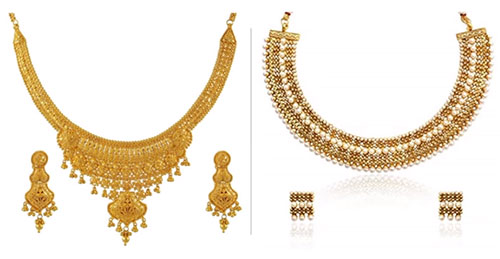
Eist Tuirseach, king of Cintra
King Eist Tuirseach is husband to Queen Calanthe and step-grandfather of Cirilla.
Eist wears this high-waisted skirted doublet with a matching cape. He wears this traveler outfit when he returns to Cintra to find Calanthe in a quarrel with Geralt in Episode 4.
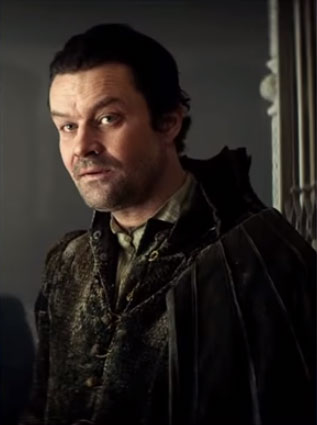
Here it is on display. Like Ciri’s cloak, you can see how much more vivid the costume is. It is made with a textured heavy upholstery velvet, influenced by medieval robes, Eastern touches, and a nod to contemporary fashion.
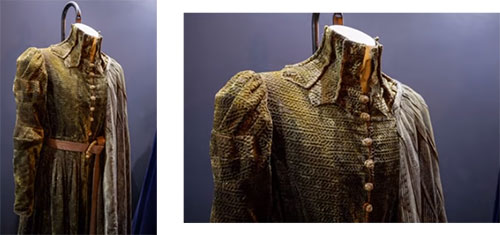
Like many of the clever fabric techniques used in the show, Tim Aslam explains, “I had a pretty good idea that the basis of the look for the show would be fabric manipulation rather than just adding trim to spice up a garment. In most cases, I had a direction but then, with the respective cutters, we played around with different fabric manipulation to all shapes for sleeves, etc”.
This brocade skirted doublet is used in the flashback scene in Episode 4 for Pavetta’s betrothal.
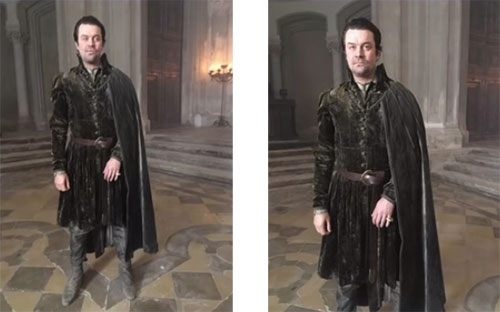
Another King Eist’s Asian-inspired coat. For the sleeves, Tim Aslam took inspiration from Chanel.
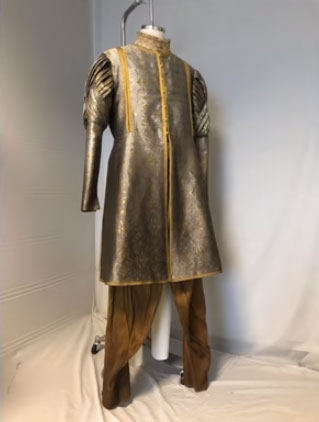
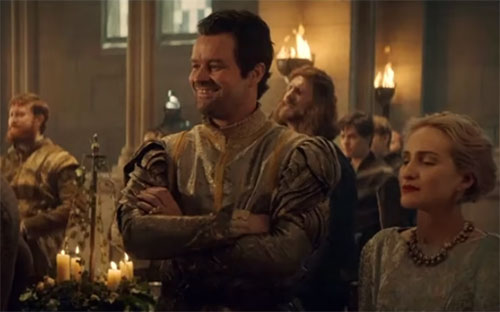
Mousesack, court druid of Cintra
Mousesack is the court druid of Cintra and advisor to Queen Calanthe.
His gold costume immediately catches the eye. This type of garment is often referred to as a houppelande, which is an outer garment for both men and women from the Middle Ages.
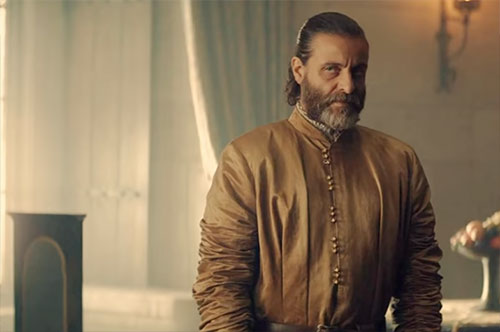
This houppelande, sometimes called the Prague houppelande, is thought to be one of the oldest known houppelandes in existence – dating to 1396 from the Czech Republic.
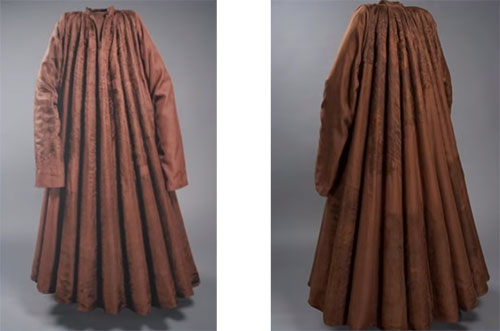
And here are some images of the costume in the wardrobe at the finishing stages.
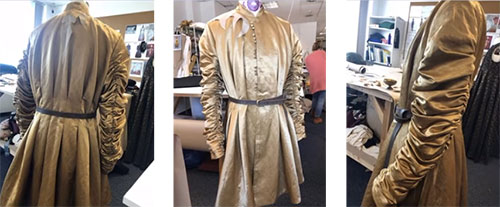
While Tim Aslam took some inspiration from contemporary fashion, this style of overly long ruched sleeves was also all the rage in the late 19th century. Like how we see on these Liberty and Co medieval-inspired dresses.
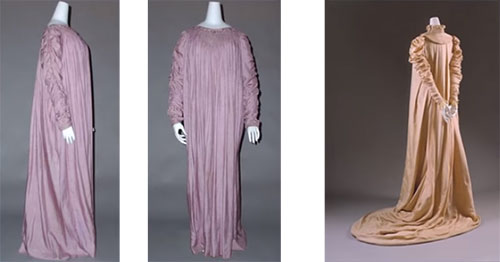
(c)


